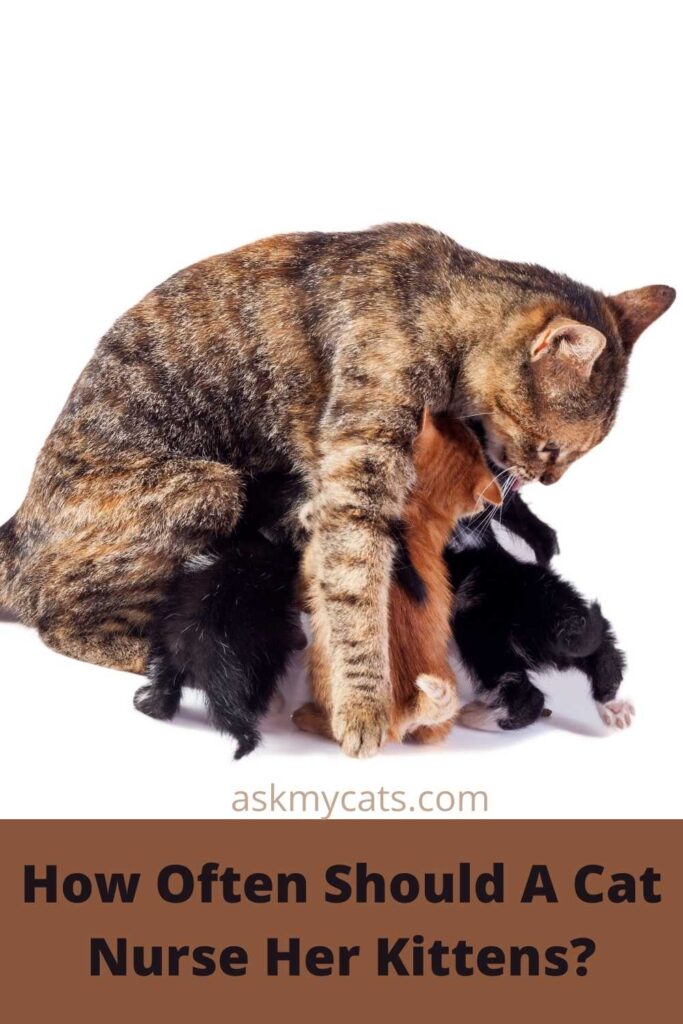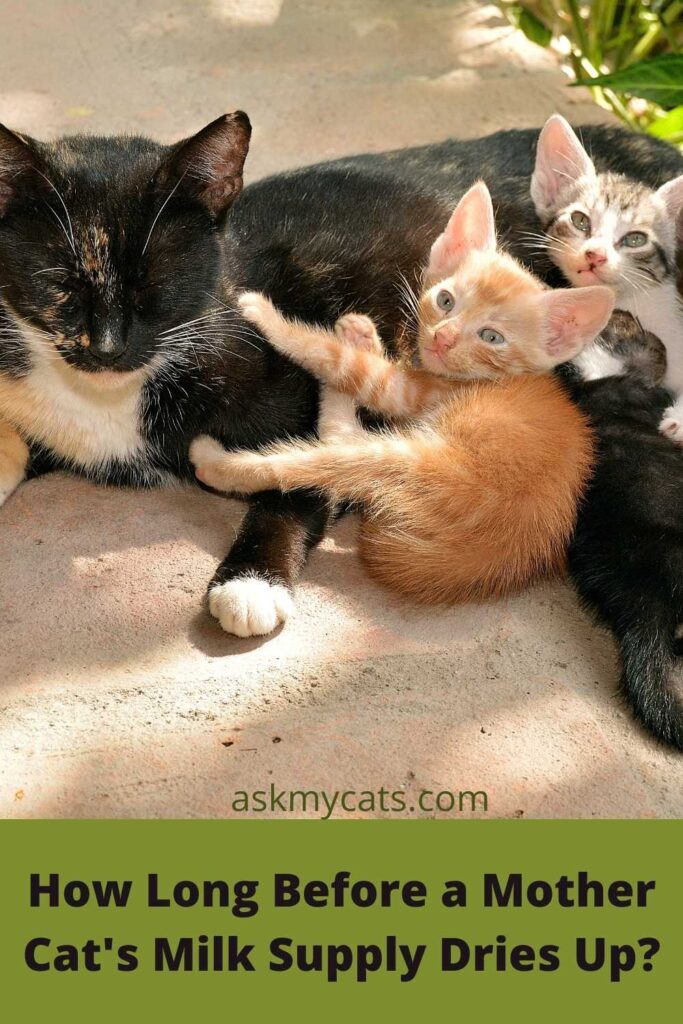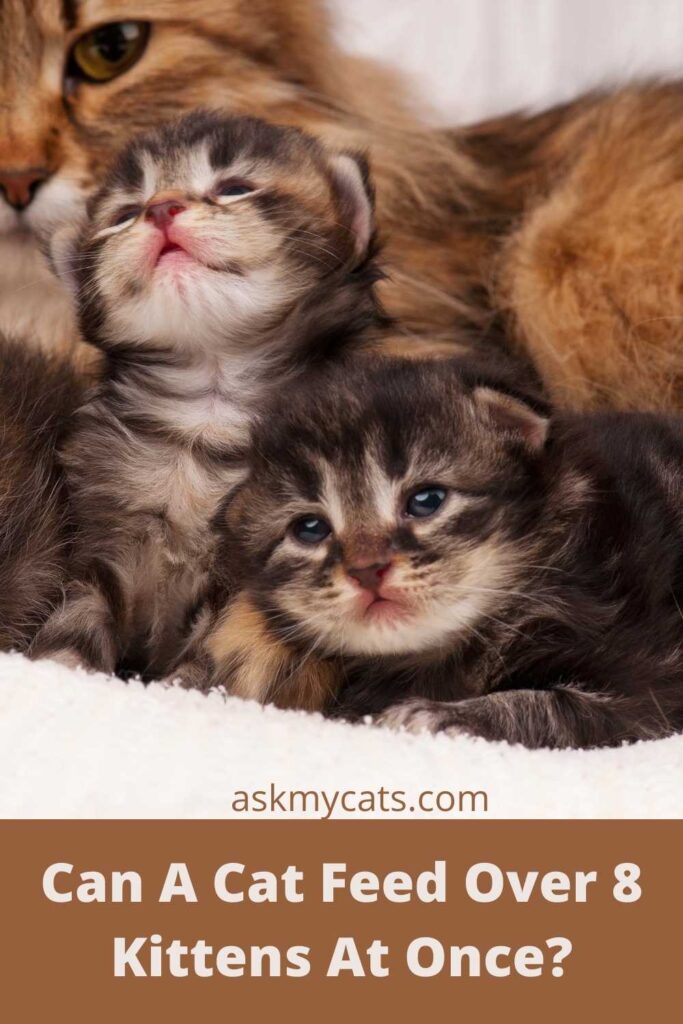Have you noticed your feline feeding multiple kittens and wondered—”How many kittens can she feed?”
I am sure her maternal instincts have intrigued you and you have doubts on your mind.
Is this habit harmful to the cat’s health, or is there another reason to be concerned?
One thing you must understand is that, unlike human beings, cats can nurse up to multiple cat babies at a time, and there is nothing wrong with it. If you can get this much clarity, most of your worries will seem puny.


Give Your Cat the Perfect Day
Get the Free Ebook!
How Many Kittens Can A Cat Nurse At Once?
Typically, a cat can nurse as many kittens as she has in her litter.
A first-time mom may give birth to only one or two kittens, but an experienced parent can, on average, have four to eight kittens per litter.
A cat’s milk supply will be enough during the nursing period to satiate her hungry kittens.
Fun fact: It’s possible that your cat mated with another male cat while she was in heat if you noticed her giving birth to kittens of various colors. Thus, this also results in an increase in the population within that litter.
There might be cases where a mother cat’s milk production is inadequate. At such times, any litter( especially more than five kittens) should not be neglected.
Supplemental feeding one to six times per day is advised when the mother’s milk supply is insufficient. There are many top-notch commercial milk substitutes on the market.
Other than warming, they don’t need any preparation. Warm these milk substitutes to 35° to 37.8°C, or 95° to 100°F.
How Often Should A Cat Nurse Her Kittens?

Less than two-week-old kittens need to be fed every two to four hours. A kitten needs to be fed every four to six hours if they are two to four weeks old.
Although it is not something very uncommon, sometimes the mother cat may occasionally begin nursing and then quit. Or, the mother cat might never actually start lactating. Some or all of the kittens may be rejected by the mother cat.
There can be times when preventing to nurse is not the only worst-case scenario you can imagine. When a kitten approaches, your feline can become hostile towards them or completely ignore them.
Sometimes the issue is not the mother cat, but rather one or more of the kittens.
There could be two reasons for this behavior:
- She struggles to nurse her kittens since they won’t properly latch, which makes her uncomfortable.
- There is a chance that there will be a rivalry for time and space if the litter is huge.
Take her to the vet: Your veterinarian should always be contacted in the event that something similar occurs. It might be necessary to bring the mother and kittens in for a checkup.
You could have a greater chance of inducing a mother cat to milk her kitten if you can figure out why she can’t feed it. Or you might have to take charge and take care of the kittens yourself.
Interesting Read: Can A Non-Pregnant Cat Nurse Kittens?
How Long Will A Cat Let Her Kittens Nurse?
The mother starts teaching her kittens the essential skills they’ll need to thrive on their own after four weeks. Kittens will learn how to feed, hunt, and use the toilet on their own during this period.
By the time the kittens are 8 weeks old, the mother’s milk will have decreased substantially, and by that time, they should be able to eat solid foods.
Some kittens will continue to nurse even after 12 weeks, although frequently, at this age, the major objective of nursing is to comfort the kittens rather than to supply nutrition.
After this period, introduce the babies to cat foods. Weaning does not take place overnight.
The process takes a while, and kittens typically stop nursing entirely between the ages of 8 and 10 weeks.
A kitten has absolutely no nutritional need for any other food besides her mother’s milk until she is weaning age.
Never offer a kitten cow’s milk since this could cause the poor thing to have stomach problems and diarrhea. However, goat’s milk is advised.
The ASPCA suggests feeding your fluffball dry cat food, but make sure it’s made particularly to meet kittens’ nutritional requirements. Kitten food can meet the increased energy needs of kittens compared to adult cats.
The little cuties also require a lot of protein to develop into strong animals.
Interesting Read: Can A Cat Nurse Kittens That Aren’t Hers?
How Long Before a Mother Cat’s Milk Supply Dries Up?

Lactation in cats begins when they get close to giving birth.
The majority of cats’ breasts run dry after around two weeks to almost two months. To put it another way, a healthy mother cat’s milk supply typically lasts until her kittens are 10 weeks old.
Following that, mother cats cease producing milk, start eating less, and start acting aggressively toward nursing kittens.
The mother cat is most stressed and labor-intensive during weeks three or four of lactation. For over a month now, the mother cat’s body has been consistently producing milk, but it is about to stop.
Less milk will also be required because the kittens are now beginning to wean themselves off of their mother’s milk.
As long as there are kittens to feed, mother cats will nurse them. Any variations in a cat’s lactation cycle are completely normal.
However, if the mother cat stops nursing before 9 weeks or continues even after the 11th week, there may be a chance of health problems.
Also, check out How To Make A Cat Produce Milk?
These are the complications that arise after a mother cat is done lactating:
Feline moms’ milk should usually be white in color, though it may occasionally be runny as lactation fluctuates over time.
- If your queen’s breasts are still red and swollen two weeks after “not” nursing, it is a sign that you must take her for a doctor’s visit.
- Mastitis (inflammation of mammary glands) is another serious condition among nursing cats that must be taken care of.
- Firm, non-painful bumps on her breast or belly could be signs of cancer, benign tissue growth, or hyperplasia of the breast tissues.
- Early milk production halting could indicate blocked glands or be a symptom of any variety of disorders.
- Continued nursing could be an indicator of a second pregnancy or even a pseudopregnancy.
Must Read: How To Tell If Kittens Are Getting Enough Milk?
Can A Cat Feed Over 8 Kittens At Once?

That’s a lot of kittens, but cats often produce litters of eight or less.
Almost 10 to 12 kittens are being fed all at once by a mother cat. Cats make excellent foster mothers and will even breastfeed kittens that are not from their own litter (out of maternal affection).
If possible, observe the kittens when the mother cats are not there to determine whether they are healthy and active. While they are feeding, keep an eye on them to observe whether the mother cat is excluding any of the kittens.
They probably won’t cause any problems if they appear to be adequately cared for, and mom cat can manage them just nicely. The mother cat can eat as much as she wants if you get her a bag of kitten chow. Have water bowls available.
You can put some kitten formula in a bowl and see if the kittens will drink it, or you can try giving them canned food if they are 3–4 weeks old or older. When mama cat isn’t present, you can give them kitten formula as a supplement if they are young and appear undernourished.
Additionally, you might want to check to see whether the other cat enters when you aren’t looking. Feral females frequently share parenting duties among themselves.
Unless the mother cat is obviously excluding one or more kittens or attempting to kill one or more of them, try to keep the kittens with the mother cat.
Not only do kittens require their moms and siblings for food, but also for social development; they must be around them.
Interesting Read: Can A Spayed Cat Nurse Kittens?
Frequently Asked Questions
Can a cat wean her 2-week-old kitten?
If possible, don’t let your feline do that.
The kitten requires its mother’s warmth because it is still learning how to control its body temperature.
You might try locking the mother cat and her kitten inside a tiny but comfortable box that is just big enough to force them to lie down together.
To create a cozy nest for the infant and mother, line the bottom of the crate with cardboard that conducts heat before adding a towel or blanket.
You keep the mother’s litter box outside the crate and allow her out so she may eat, drink, and use the restroom.
You will need to get some commercial kitten milk powder, follow the instructions, and begin bottle feeding the kitten if the mother cat rejects it or isn’t providing it with enough milk for any reason.
Final Words
Lastly, what we would like you to know is that a mother cat is vocal about her problems; you just need to identify the signs. She should be able to peacefully feed her kittens as long as they need it.
The veterinarian can handle both minor and major issues, and they will support you until you feel well-informed.
How long did your cat nurse her young? Let us know in the comments section.
When did she start weaning her kittens and end nursing?
